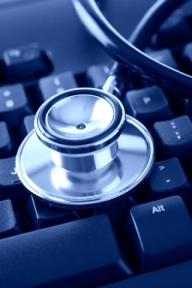Medicine 2.0: the impact of web 2.0 on healthcare?
Welcome to the 30th edition of Medicine 2.0, the blog carnival devoted to articles that analyze the current and potential impact of web 2.0 technologies on medicine and healthcare.
“Medicine 2.0” 101
The first question is, of course, “What exactly is Medicine 2.0?”. The second, “Who cares?”. The third, “Why?”
Anthropologists are here to help. Who better to help understand emerging artifacts of the health and medical tribe, as evidenced by the fantastic lecture An Anthropological Introduction To Youtube given to the Library of Congress by Professor Michael Wesch. As Open Thinking suggests, the video which is 55 minutes long provides an “excellent backgrounder on social media, user-generated content, and online communities through the lens of anthropology.”
the health and medical tribe, as evidenced by the fantastic lecture An Anthropological Introduction To Youtube given to the Library of Congress by Professor Michael Wesch. As Open Thinking suggests, the video which is 55 minutes long provides an “excellent backgrounder on social media, user-generated content, and online communities through the lens of anthropology.”
If you are more the PowerPoint type, you can access the great slide presentation and list of websites provided by eHealth: see Web 2.0 in Clinical Research.
The Future of Medicine and Health 2.0
Admittedly, the Medicine 2.0 field is still small and emerging. But, how will it grow? What new healthcare outcomes will it enable and support? What may be the trade-offs to consider, if any?
The Healthcare Blog offers a Description To Action: The Future of Health 2.0 Tools. “What makes these efforts particularly interesting is that, through a collaborative Web-based process, they attempt to distill and document the current best knowledge about any topic. In health care, the goal is easily accessible state-of-the-science information, the equivalent of ongoing medical/scientific review articles that detail what we know and don’t know about life and care processes.”
For example, have you ever thought why, if scientific knowledge is constantly evolving, museums of science and medicine do not update their content more often? Biomedicine on Display outlines visions for The participatory museum what’s a medical museum 2.0 like?, including a superb questions, “How can our exhibitions be perpetual beta rather than finished?”
Now, participating in defining and updating exhibitions, vs. simply acting as passive spectators, will translate into a neuronal impact on museum visitors’ brains, strengthening some cognitive skills and weakening others. We can expect The Atlantic Monthly to publish an article in, say, 5 years, asking Is Medicine 2.0 Making Us Stupid? In support of this prediction, you may enjoy our SharpBrains post on Can Google Kill Neurons and Rewire Your Whole Brain?
Tools and more Tools
Medicine 2.0 is predicated on the emergence of tools that enable interaction and communication in ways that simply were not possible a few years ago.
Digital Pathology Blog asks Will the iPhone Change Medicine Forever? presenting this scenario: “For example, the iPhone shows a graphic of a slice of the human brain. It allows the med student to see 10 push pins on different parts of the brain, click on each one, and attempt to correctly name each feature. If the answer is wrong, the correct answer is displayed so the med student can learn from that mistake. A medical school student using this software on his iPhone approached one of the doctors involved in its development and said “I learned 10 new anatomical terms today while waiting for the bus.
Managing and processing information will become as critical as breathing air. Efficient MD suggests ways to store, categorize and retrieve information from a variety of online and printed sources with How Doctors Can Use Evernote, while Tomography Blog lists specific search engines for Diagnostic Imaging.
There’s more. Allan’s Library points out tools for Making Academic Web Sites Better, and David Rothman introduces us to SemanticMEDLINE, a new tool from Cognition Technologies.
How do all these tools change the day-to-day practices of clinicians and researchers? Dr. Mouse, a Peruvian surgeon, explains (in Spanish) Como Uso Web 2.0 en Mi Practica Medica — how web 2.0 is already enhancing his research and clinical practice.
Challenges, A Few
“Don’t forget, patients and your future employers will find what you publish about yourself and your life on the web. So use it wisely ” Wise words of advice in Web vs real life: Advice for medical students from Bertalan at ScienceRoll.
Clinical Cases and Images provides the context, covering a recent negative study, published in the Journal of General Internal Medicine, that questioned potential patient privacy issues and conflicts of interest. See Content of Weblogs Written by Health Professionals: More Bad than Good?
Science in the Open reports from BioBarCamp — Meeting friends old and new and virtual, how, while “many people expressed an interest in Open Science Open Data, or some other open stuff,” it was clear that “many people meant many different things by this”. Establishing commonly-accepted definitions, standards and policies will be a must.
Also a must will be upgrading to existing technologies. This is a not-so-easy task. Crossover Health explaisn in Dude! The $100M VistA Open Source Opportunity: “What the heck — $11B project without any of this stuff in place, no clear plan, no direction, no people to do the work, and constant changes.”
Finally, in case you wonder whether Twitter is mature enough for wide professional adoption, Laika’s MedLibLog thinks perhaps not yet: Twitter Traumas: Twitter’s Janus Face.
Final Details
And that’s all for this edition. Michelle vs the Med Student will host next one on August 24th. You can submit your articles through the official form.
In the meantime, you can participate in the Medicine 2.0 Microcarnival Launch!, the latest experiment launched by Bertalan on Friendfeed.
Enjoy the week!


